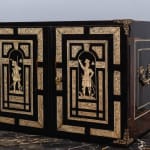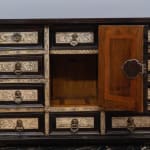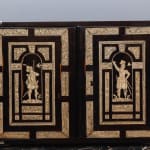A Renaissance Lombardy silver mounted and ivory inlaid ebony cabinet, Lombardy, Italy, date circa 1600-25
Height 39 cm, width 55 cm, depth 32 cm.
Further images
A magnificent Renaissance Lombardy silver mounted and ivory inlaid ebony cabinet, of rectangular form, the top inlaid with ivory panels and silver pierced foliate mounts to each corner above two doors with silver pierced hinges and keyhole with key to the right, each door lavishly inlaid with outer engraved foliate scrolled ivory panels and centred by a gadrooned border enclosing shaped panels headed by a mask head above an elongated panel with arched top, showing on the left a huntsman wearing a doublet and hose and turban and holding a sword and staff with bird flying over, the panel to the right showing another huntsman wearing doublet and hose, a plumed helmet and sword, again with a bird flying nearby, both figures on a rocky ground. The inside of the doors, again lavishly inlaid with outer foliate borders enclosing at centre a double framed panel with the same huntsmen in silhouette. The inside of the cabinet fitted with four tiers of drawers to either side, each inlaid with engraved ivory panels featuring pairs of birds to include a swan, turkey, hawk, pheasant, heron, owl and other wild fowl, each pair centred by a mask head and ring pull handle, the centre of the inner section with another similar drawer below a larger interior door ornamented with a mask head and shaped ivory panels engraved with fruit and foliage and centred by an elongated panel with an arched top engraved with a man wearing protective body armour and long leather sandals standing below billowing clouds and beside a small tree, the sides of the cabinet inlaid with two rectangular ivory panels centred by a carrying handle and silver mounts to the lower corners
Lombardy, Italy, date circa 1600-25
Height 39 cm, width 55 cm, depth 32 cm.
Literature: Gilda Rosa, “I Mobili Nelle Civiche Raccolte Artistiche di Milano”, 1963, no. 131, for a very similar example.
This extremely fine cabinet originates from Lombardy and exemplifies the infinite skills of the Milanese craftsmen during the early seventeenth century. Enclosing nine small drawers and a central compartment within its interior, this collector’s cabinet was used to store precious objects and personal documents. A very similar inlaid ebony cabinet is in the Metropolitan Museum, New York (exhibited at the Metropolitan Museum of Art, “Thinking Outside the Box: European Cabinets, Caskets, and Cases from the Permanent Collection (1500–1900),” December 2010-October 2011). As here, the exterior and interior surfaces are richly decorated and feature similarly shaped panels, pairs of birds, very similar huntsmen and almost identical handles and pierced silver mounts at the corners. The main difference is that the example at the Metropolitan has a single fall front featuring at centre an image of Perseus rescuing King Cepheus’ daughter Andromeda, by slaying the sea monster. Another comparable cabinet can be found in the Museum of Decorative Arts in Milan.
1
of
3







